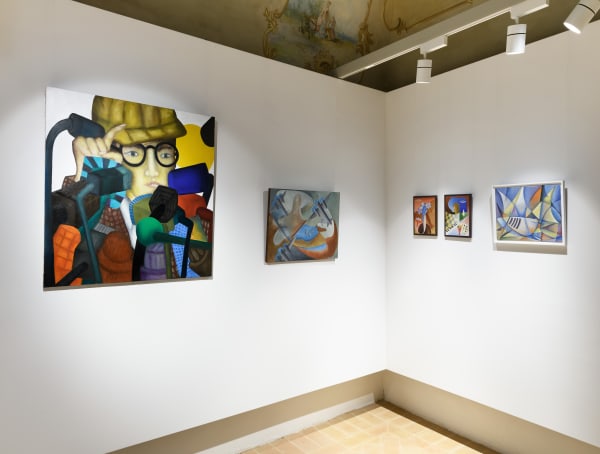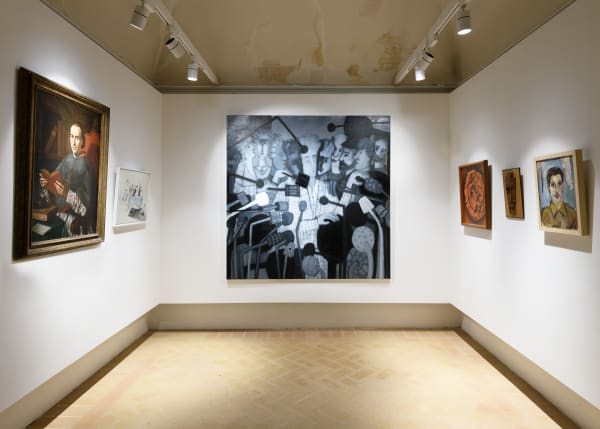From June 28, 2024, to January 12, 2025, the new exhibition "Vis-à-vis. Ritratti moderni e contemporanei", curated by Elsa Barbieri, Massimo Francucci, and Giuliana Pascucci, will be showcased in the halls of the Civic Museums of Palazzo Buonaccorsi.
Featuring over 60 works juxtaposing masters of the past and contemporary artists, both Italian and international, the exhibition aims to offer a fresh reflection on 18th-century and contemporary portraiture.
Displayed are works by 18th-century authors such as Pier Leone Ghezzi, Sebastiano Ceccarini, Carlo Magini, alongside contemporary artists including Evgeny Antufiev, Eduardo Arroyo, Matthew Attard, Joseph Beuys, Marco Cingolani, Michelangelo Consani, Fabrizio Cotognini, Enzo Cucchi, Thomas De Falco, Antony Gormley, Maggi Hambling, Diango Hernández, Leiko Ikemura, Jiri Kolar, Mark Manders, Annette Messager, Fulvio Morella, Roman Opalka, Laura Paoletti, Vettor Pisani, Carol Rama, David Reimondo, Klaus Rinke, and Kiki Smith. These are presented alongside prestigious museum collections, notably including 20th-century authors like Nanda Vigo, Osvaldo Licini, Aligi Sassu, Luigi Bartolini, through an exhibition path winding through all floors and fascinating rooms of Palazzo Buonaccorsi.
An original artistic encounter spanning from the 18th century, the Golden Age of Marche portraiture, to the contemporary era, tracing the study trajectories of how visual perception—of a portrait—is the result of a process involving selection, integration, and intuition, where beyond visual faculty, real data, consciousness, emotional attachment, individual memory, and moral focus intervene.
When we look at a portrait, we think we see an individual; it seems obvious: the portrait is, by a definition as correct as it is simple, the representation of a person considered in and of themselves. But what connection exists between portrait practices—be it self-portrait, mask, caricature, or even disguise—and the issue of defining the individual? Can we consider the portrait the visual representation of a proper name? Is there an identity relationship between the portrait and the individual it represents?
"A viso a viso," as Alessandro Manzoni wrote—men and women meet, and sometimes collide, exchanging glances, gestures, and words, observed by other men and women in a public dimension within which emerges the struggle for recognition that animates portrait practice.
Following a phenomenology spanning centuries, periods, avant-gardes, canons, and different cultures, Vis-à-vis starts from the various possibilities of figurative practice to which the pursuit of truth, since the Enlightenment, gave decisive impetus. Short-circuiting the traditional perceptual mode within the exhibition space, the show encourages social interaction and behaviors of individuals, both portrayed and visiting, who meet face to face under each other's gaze. This results in an investigation that treats the question of the portrait in close reciprocity with that of the individual and representation.
Looking to the past, the pursuit of truth characterized much of the 18th century, giving new impetus to two genres that more than others seemed to follow this intention: portraiture and still life. The use of having the likeness of loved ones painted and jealously preserved extended from the aristocratic classes to the bourgeoisie of great and medium fortune, leading to an increasing number of artists tackling the genre. The Marche painters were no exception to this, and indeed, they knew how to breathe new life and splendor into the genre by proposing some of the most advanced portrait models of the century, at least until the decoding of the portrait as a Grand Tour souvenir by Pompeo Batoni.
Through the selection of exhibited works, the exhibition aims to account for both the evolution of the artistic genre of portraiture and some of the most important, vivid, and sometimes surprising 18th-century specimens. This also highlights the different possibilities given to the painter at the time, to characterize the figure with the surrounding environment, to insert elements that recalled the social role and passions of the subject portrayed, as well as the depth of psychological reading, which often depended on the level of familiarity between the artist and the portrayed subject.
June 28, 2024










